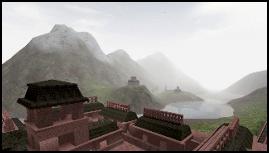Mayans to moa hunters: virtual worlds
Monday, 20 July 2009, 1:12 pm
Press Release: Massey University
Monday, 20 July, 2009
Mayans to moa hunters - virtual worlds for learning, travel and play

A scene from Dr Champion’s Mayan civilization virtual heritage site.
From moa hunting to Moriori society, life as an early settler to exploring Antarctica – bygone and distant aspects of New Zealand life could become more accessible thanks to a Massey new media expert’s vision.
Erik Champion, associate professor of new media at Massey’s Auckland School of Design at Albany, says virtual worlds and computer games are not only the domain of teenage cyber-junkies – they have enormous potential as intellectual tools to explore and interact with ancient cultures, distant places and previously inaccessible or dangerous environments.
In line with emerging trends overseas, he is seeking designers to create more New Zealand-themed virtual worlds through the use of advanced tools such as curved mirrors, screen warping and biofeedback receptors.
He wants to encourage more designers into virtual world and game research to bring to life some of New Zealand’s historic, cultural and geographic wonders. “The challenge is to find new interactive ways to experience things through digital media,” he says.
Dr Champion, an expert in using game engines and virtual environments to recreate heritage sites, says these tools and displays will soon become more popular alternatives or extensions to travel and book learning, providing access to famous archeological and museum sites around the world, as well as a means to vividly experiencing bygone civilizations.
Advertisement - scroll to continue reading
In his research and teaching he has used new digital tools to create websites and interactive games on Mayan civilization, Marco Polo’s travels, Egyptian gods and an Australian mining town. Other applications of digital media include recreating fragile historic and tourism sites such as Stonehenge (a pre-historic monument in England), Venice, and Machu Picchu (a pre-Columbian Inca site in Peru) that may one day be off limits or even destroyed by mass tourism.
As the design school’s Director of Postgraduate Studies and Research, he wants to see more students from across a range of disciplines – design, architecture, computer and information studies, engineers and town planners – pursue research into educational forms of virtual reality such as heritage sites, interactive game design and urban development.
Dr Champion, a New Zealander who previously worked at the University of Queensland and Sydney's University of New South Wales, says “creating appropriate interaction that is easy to learn but allows expressiveness can offer different ways of learning, communicating and building.”
He says technology, design and culture-oriented New Zealanders have much to contribute in the area of digital media. He has just returned from a Fulbright-funded study trip to the United States where he presented his research on virtual environments at the Harvard Graduate School of Design, Stanford University, the Massachusetts Institute of Technology (MIT), the Carnegie Museum of Natural History and other academic institutions.
ENDS
Advertisement - scroll to continue reading
a.supporter:hover {background:#EC4438!important;} @media screen and (max-width: 480px) { #byline-block div.byline-block {padding-right:16px;}}
Using Scoop for work?
Scoop is free for personal use, but you’ll need a licence for work use. This is part of our Ethical Paywall and how we fund Scoop. Join today with plans starting from less than $3 per week, plus gain access to exclusive Pro features.
Join Pro Individual Find out more
Find more from Massey University on InfoPages.